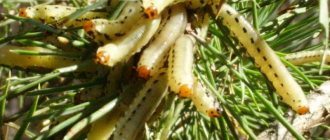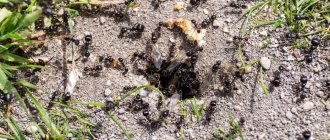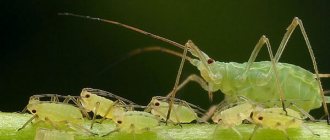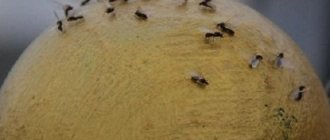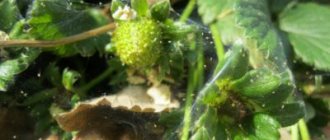Soap solution Alcohol solution Garlic Onion Decoctions and herbal infusions Rosemary essential oil
Spider mites are small insects, but they cause enormous harm . Loves high temperatures and low humidity. Feels great on indoor plants and in greenhouses. Mites feed on the cell sap of leaves , which leads to their yellowing, death and death of the plant.
It is very difficult to see such a mite ; cobwebs appear on the leaves already at a late stage of infection.
Let's get to know the spider mite
Spider mites are the smallest insects, measuring less than 1 mm in adulthood. Without the help of a magnifying glass, a tick is visible only as a dot, but it causes a lot of damage. The adult tick is red or brown in color, the larvae are greenish.
The spider mite lives for about 1 month, but during this time it manages to breed over a large area. The laid eggs turn into larvae in 3-5 days, and it takes the same number of days for it to turn into an adult tick. In 1 day, a female spider mite can lay up to 450 eggs. Female ticks are very tenacious and often overwinter in the ground, and larvae can hatch from the eggs even after 5 years of preservation in the ground.
Attention. If you have removed all the plants from your garden, spider mites may hide in the ground for the winter.
Spider mites under a microscope
Prevention
There are several recommendations on how to prevent mites from infesting roses. Basic rules include:
- regular inspection of the bushes, special attention should be paid to “secret” places (the underside of the leaves);
- If you find a web, you must make sure that it belongs to a tick. Its web has a very fine pattern, its color is yellowish with a whitish coating. Under it you can see hundreds of moving particles - these are the newly born pest larvae running around;
- frequent spraying of plants with cool water during hot, clear weather;
- Wipe the leaves once a month with a herbal solution or soap solution. By the way, they need to process not only plants, but also pots, shelves, window sills, frames;
- timely removal of faded buds and yellowed leaves - it is the weakened parts of the plants that attract the pest;
- carrying out spring sanitary pruning of roses and removal of wild growth. Plantings should be sparse;
- Spider mites love orchids. Therefore, in order to protect roses from insects falling on them, they should be protected from such an unfavorable neighborhood;
- planting useful plants next to roses that produce insect repellent substances (calendula, marigolds, chamomile, onions, nightshades)
How are spider mites harmful?
Spider mites settle on the reverse side of the leaf of a young garden crop, pierce a hole in the leaf with their proboscis, and suck all the juices out of it in this area, then move on to another place. After the mites have “worked”, a whitish marble pattern is formed on the sheet. There may be small thin white webs hanging from the leaf. The leaf then turns yellow and dries out.
Attention. Spider mites are also harmful because they carry gray rot spores.
Pest-resistant varieties
Many modern hybrids are capable of holding the defense against pest invasion. These varieties have good immunity and are resistant to adverse weather conditions. It can be difficult for mites to approach healthy and strong plants.
Popular varieties:
- tea - hybrid - Sophia Loren, Gloria Day, Erotica, Renaissance series, Landora, Mainzer Fastnacht;
- floribunda – Allotria, Bonica, La Sevillana;
- climbing roses - Flamentand, Gold Stern, Golden Showers.
But even resistant varieties of roses will not be able to withstand the invasion of spider mites without additional help. Therefore, any plant must be grown with special attention and care.
How to prevent mass reproduction of spider mites?
To prevent spider mites from breeding over a large area, we take the following actions :
- We maintain air humidity in the greenhouse above 70%; moisture has a bad effect on mites, and at 80% they die.
- In the fall, we dig up the soil in the greenhouse, especially trying in the corners.
- We burn all the plants after they have been harvested.
- Spider mites reproduce well if the soil is saturated with potassium fertilizers - we add more phosphorus fertilizers.
- Ticks may remain on the frame and trellises - we disinfect them.
- We plant calendula bushes between the vegetables.
Causes of infection
If the tick has already reached your garden, then in a couple of weeks its numerous offspring will “rule” all the flora growing in the area. It does not bypass vegetables, fruit trees or flowers. The pest spreads by air, that is, it is carried by the wind from plant to plant. Pets can also “help” the parasite (bring it on their fur). Typically, territory acquisition occurs during hot, dry weather when dusty conditions occur. First, the mite falls on plants growing on the outskirts of the site, and then, with each new wind flow, it moves inside the garden.
Most often, those roses that are affected by mites are those that have not received proper human care. Without regular fertilizing, tillage, pruning, plant immunity is weakened - such flowers cannot resist the onslaught of the enemy. The situation is aggravated if the plantings are very thick and shoots grow in them.
Fact! Illiterate care of roses is the cause of spider mites. With insufficient watering and dense planting, roses have little chance of survival.
How can you kill spider mites?
Spider mites can be destroyed in the following ways:
- Pick off yellowed leaves and burn them if there are few such leaves.
- With the help of living creatures - enemies of spider mites
- Planting plants and vegetables next to vegetable crops whose smells repel spider mites: garlic, onions, wormwood, tomatoes, calendula
- If the leaves are not severely damaged by spider mites, then you can spray them with folk remedies
- We treat noticeably damaged plants with biological products or acaricides
Attention. Before spraying, do not forget to remove the cobwebs from the leaves, otherwise the solution will not get on the mites.
Effect of garlic diallyl disulfide on insects
Garlic actually copes well with many pests if their colonies are not too large. But it does not kill insects, but repels them.
The repellent effect of garlic is due to the presence of the aforementioned diallyl disulfide. Insects, in search of food, navigate mainly using their sense of smell, which is fantastically acute. For example, a cabbage butterfly can smell a cabbage leaf a kilometer away from the garden bed.
Diallyl disulfide is a pungent-smelling compound. When contacted with leaves, solutions containing this substance mask the natural aroma of the plant and make it “invisible” to the pest. Thus, garlic infusions help cope with those insects that come to the garden “by smell”:
- cabbage butterfly;
- carrot fly;
- cabbage scoop;
- cabbage moth;
All pests are repelled by garlic +6 (click to expand)
- whitefly;
- aphid;
- codling moths;
- cruciferous flea beetle;
- weevils;
- Colorado beetle.
Diallyl disulfide is a stable compound, so the protective effect of garlic products lasts for several days in good weather.
How to kill spider mites using living creatures?
Spider mites can also be fought with the help of their enemies. The worst enemies of spider mites are the following insects:
- Ladybugs and their larvae. An adult ladybug is on average up to 5 mm in size, and the larvae can reach 18 mm in length. These bugs live for about 1 year, rarely up to 2 years. In 1 day, a ladybug eats up to 40 spider mites, and over a lifetime, up to 800. Ladybug larvae are even more voracious; they eat up to 70 spider mites per day. Bugs overwinter under fallen leaves and in the cracks of houses.
Ladybug
Ladybug larva
- Predatory mites (Phytoseiulus, Amblyseius). Phytoseiulus is an adult spider less than 1 mm in size. The female lays eggs in a spider mite colony. In 1 day, a predatory mite eats 5 spider mites, and the larvae that hatch from the eggs eat 10-15 eggs of their enemy. To attract predatory mites to your garden, you need, in addition to the main crops, to plant plants that they like: dill, mustard, and an ornamental plant - phacelia. And in order for predatory mites to remain on your site next year, you need to create good conditions for them to winter: wrap thick tree branches with pieces of cloth, and they will live there.
Predatory mite Phytoseiulus, enlarged under a microscope
- Lacewings, another name for the lacewing, and their larvae. Insects with greenish transparent wings are up to 1.5 cm long. The entire family of lacewings got their name because of their convex, iridescent golden eyes. The larvae of the flyweed are especially voracious - they can eat up to 150 spider mites or aphids in 1 day. To survive the winter, lacewings hide under fallen leaves in the garden, in cracks in houses or in the attic.
Lacewings
- Hoverflies. These insects are a bit like wasps - they have the same yellow-black stripes on their backs, they prefer to sit on yellow flowers and feed on their nectar. The female hoverfly lays eggs near colonies of aphids or spider mites, then the hatched larvae eat these harmful insects. Hoverflies like the smell of cumin, parsley, cilantro, and plantain; by planting them between the rows of vegetable crops, we will save the vegetable harvest. For the winter, hoverflies burrow into loose soil under trees.
Hoverfly
- Earwigs, another name for earwigs. Their length is approximately 2 cm. These insects eat everything: both small moving insects from the animal world - spider mites, aphids, and plants - vegetables, fruits, leaves. They are nocturnal, and during the day they hide in dark, damp places.
Earwig
- Ground beetles. They can be small - up to 1 mm, or large - up to 10 cm in length. These beetles feed on small insects (aphids, spider mites) and plants. In agriculture, they are specially bred to destroy harmful insects and weeds.
Ground beetle
- Spiders. All spiders are predators; they eat various small insects, including spider mites.
Spider
In addition to the listed insects, vegetable pests are eaten by: birds, bats, frogs, hedgehogs and lizards.
How to destroy spider mites using folk remedies?
Folk remedies are more suitable for prevention against spider mites or at the very beginning of their appearance. If mites have already infested all the plants, then acaricides need to be used.
Method 1. Hydrogen peroxide
- Take 2 tbsp. l. hydrogen peroxide 3% and 1 liter of water, mix.
- If it is about 20 degrees Celsius outside, we spray the plants in 3-4 doses, every 5-7 days.
- If the temperature is about 30 degrees Celsius, we spray the plants in 3-4 doses, every 3 days.
Method 2. Ammonia
- Take 1 tsp. ammonia and 1 liter of water, mix.
- If it is about 20 degrees Celsius outside, we spray the plants in 3-4 doses, every 5-7 days.
- If the temperature is about 30 degrees Celsius, we spray the plants in 3-4 doses, every 3 days.
Method 3. Turpentine
- We pour the turpentine into small jars and place it between the initially affected plants.
- We temporarily cover the plants along with the jars with film. The smell of turpentine will kill the parasites.
Method 4. Tobacco
- Sprinkle crushed tobacco into dust on vegetable leaves damaged at an early stage.
Method 5. Datura decoction
- Fill 1 kg of dried datura herb or 3 kg of fresh plant with water to cover the herb and boil over low heat for 3 hours.
- When the broth has cooled, strain it, dilute it with 10 liters of water, and spray the leaves of vegetables affected by spider mites.
Method 6. Datura infusion
- Pour 100 g of dry dope into 1 liter of water, let it sit for 1 day, then spray the plants with spider mites.
Method 7. Dandelion infusion
- Pour 0.5 kg of dandelion leaves into 10 liters of water, leave for 3-4 hours, and spray the plants with spider mites.
Method 8. Calendula infusion
- Pour 400 g of calendula flowers into 4 liters of water, leave for 5 days - the infusion is ready for use.
Method 9. Sorrel infusion
- Pour 300 g of sorrel roots into a bucket of water, leave for 5 hours, then you can spray the plants affected by spider mites.
Method 10. Yarrow decoction
- Pour boiling water over 500 g of dried yarrow herb and cover with a lid.
- When the broth has cooled, dilute it with 10 liters of water and spray the leaves of vegetables with spider mites.
Method 11. Infusion of onion and garlic peels
- Pour 200 g of onion and garlic peels into a bucket of water, leave for 1 day - and you can destroy spider mites.
Method 12. Garlic infusion
- Take 2 heads of garlic, chop it, add 1 liter of water, and leave for 5 days.
- Strain the infusion, pour in another 1 liter of water, and spray the vegetable plants that have spider mites.
Method 13. Mustard infusion
- Take 60 g of mustard powder, add 1 liter of water, leave for 3 days, and you can spray the plants.
Method 14. Laundry soap solution
- Grate 20 g of laundry soap, pour 1 liter of hot water into it, stir until the soap dissolves.
- We soak a napkin in the solution and wash the leaves of garden plants on both sides. Make sure that the soap solution does not get on the roots of the plant.
Attention. Spraying of plants should be carried out in the early morning or evening - in the sun the effect of the drug decreases.
Preventive measures
Of course, preventing disaster is much cheaper than dealing with the consequences. Preventive measures against spider mites include:
- daily inspection of indoor flowers
- quarantine for new shoots, seedlings with complete isolation from domestic plants
- regular ventilation of rooms and artificial air humidification
- systematic spraying of flowers
- periodic illumination of greenery with an ultraviolet lamp (once a week for 1 minute).
Remember! Ticks are resistant to aggressive external influences, but are not immortal. Victory in the fight will still be yours!
| Flower grower's lunar calendar for July 2020 |
How to destroy spider mites with biological products?
Biological products are made from microorganisms and plants. They are not harmful to humans, but they destroy spider mites. The following drugs have proven themselves to be effective:
- "Akarin"
- "Aktofit"
- "Agravertine"
- "Vertimek"
- "Kleschevit"
- "Fitoverm"
Attention. Spraying should be carried out 3-4 times, or even more, since all drugs do not affect eggs laid by the female, but only on adults and larvae. When the larvae hatch from the eggs, spraying must be repeated.
All biological products do not act immediately, but after 8-12 hours. The drug must be diluted as written in the instructions on the package.
Attention. If you spray plants against spider mites several times a season, the preparations need to be changed, since the next generations of mites adapt to the poison and it does not affect them.
The effect of garlic on pathogenic microorganisms
The antimicrobial and antifungal effect is due to the large amount of phytoncides that garlic releases when cutting the cloves. The arrows of this plant can also be used to prepare medicinal preparations, however, such remedies will be inferior in effectiveness to those prepared from the cloves.
The mechanism of action of garlic phytoncides on pathogenic microorganisms includes several processes. First, they destroy the cell wall. Then they penetrate the cytoplasm and inhibit the enzymatic activity of the pathogen and its respiratory activity.
Not all phytopathogens are equally sensitive to garlic phytoncides. The causative agents of the following infectious diseases react most actively to garlic preparations:
- late blight;
- powdery mildew;
- fruit rot.
Garlic destroys not only microbial spores, but also mycelial cells, suppressing the proliferation of fungi.
Important! Garlic infusions are not effective against downy mildew. Garlic itself often suffers from peronosporosis, so it is not able to protect other plants from it. For the same reason, reports of the effectiveness of garlic remedies against fusarium are questionable.
Garlic phytoncides are destructive not only for pathogenic flora. In 3 minutes they kill the hay bacillus, which is beneficial for soil and plants. Therefore, after using garlic preparations, it is necessary to repopulate the area with this microorganism by treating it with Fitosporin-M.
How to kill spider mites with acaricides?
In addition to crawling spider mites, acaricides also destroy eggs. And yet, at one time, these chemicals cannot destroy all mites, but only 50-70%, the second time - close to 90%, the third time - the remaining ones. If it is cool, we re-process vegetable bushes after 4-6 days, if it is hot, then earlier. The best acaricides:
- «Apollo"
- "Nisoran"
- "Oberon"
- "Sunmite"
- "Flumite"
- "Floromite"
Attention. Acaricides are toxic agents that are harmful to people, so they should be used last if other methods do not help.
So, now we know how to destroy spider mites if they appear in your garden.
Biochemical composition of garlic
The better the garlic is ripe, the more valuable elements it contains. Biochemical analyzes reveal the presence of seventeen mineral elements in garlic cloves: potassium, phosphorus, sulfur, iodine (see → use as a supplement), copper, manganese, etc.
In addition, garlic contains the following components important for the grower:
- Phytoncides. This term refers to substances that can destroy microorganisms. Garlic phytoncides have exceptional activity. Laboratory experiments prove that they kill Koch’s bacillus 6 times faster than the popular antiseptic “carbolic acid” (in 5 minutes versus 30).
- Diallyl disulfide. This substance is an organosulfur compound that gives garlic its specific smell.
In general, there are more than a hundred different sulfur-containing substances in garlic cloves. All summer residents who have at least once used colloidal sulfur on their plots are aware of the benefits of sulfur in the fight against plant diseases and pests. Thus, garlic can be considered a natural substitute for this chemical.
Garlic is not a simple substitute for colloidal sulfur, but an improved one. It contains essential oils and phytoncides, which are not found in the chemical preparation.
Video: Spider mite. How to quickly and reliably defeat a pest?
Let's learn more about growing and diseases of vegetables:
- What should not be fed with ash?
- There is one barren flower on cucumbers in the open ground, in a greenhouse: why, what to do
- Arugula - cultivation and care, pest control
- How to grow hot chili peppers on a windowsill at home
- Perennial onion - growing from seeds through seedlings and in open ground



